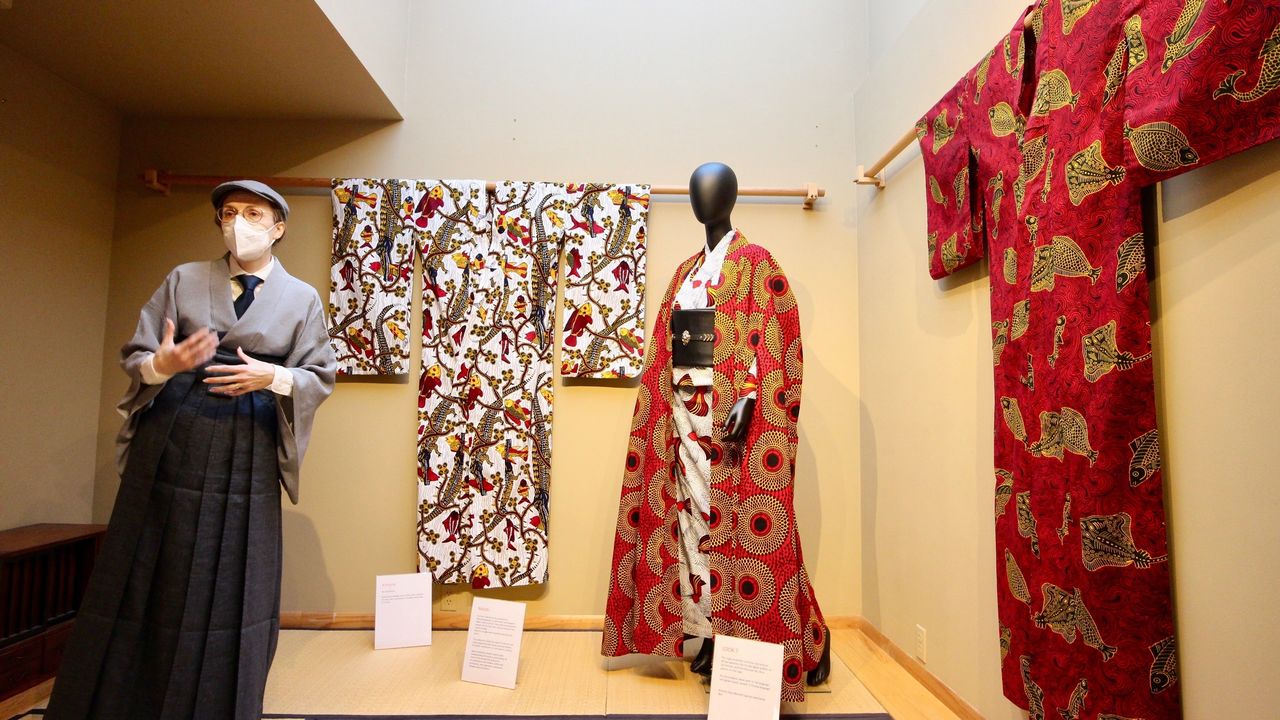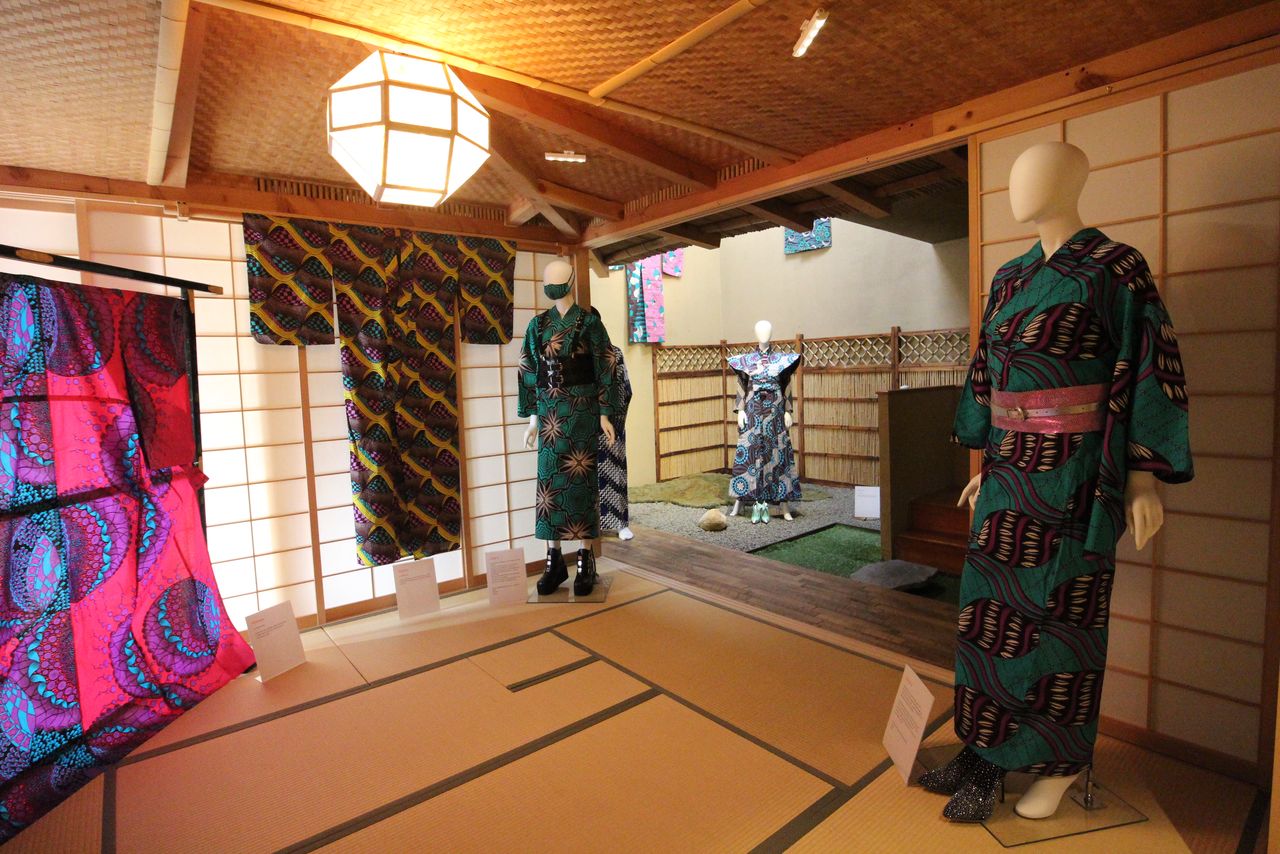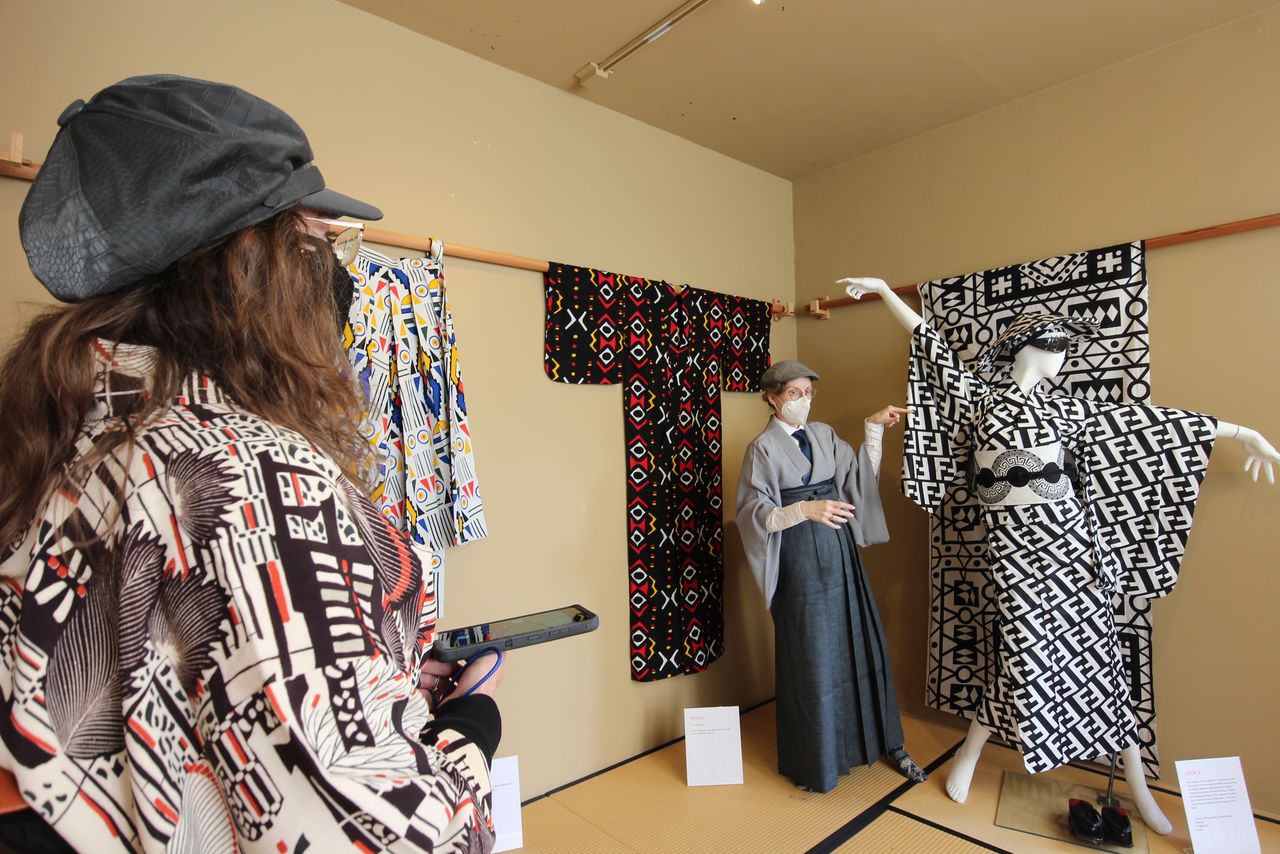
Spree Kingyo: the German Kimono Stylist Unearthing New Possibilities for the Future of Kimono Culture
Culture Fashion- English
- 日本語
- 简体字
- 繁體字
- Français
- Español
- العربية
- Русский
European Kimonos on Show in New York
At the end of 2021, a somewhat unusual kimono exhibition called “Kimono Visionaries” opened in New York. Over the four days of the project, 25 pieces were shown, all of them the work of Tia Oguri, a London-based South African designer. The kimonos were characterized by colorful African wax prints and daring and innovative textile designs, paired not only with traditional Japanese obi made from hakata-ori textiles but also with leather belts, high heels, and other Western styles. These original twists on traditional Japanese styles proved a big hit with visitors, drawing a crowd of Japanese residents living in the United States and regular New Yorkers with an interest in Japan.

The “Kimono Visionaries” exhibition was held in New York last year. (© Kasumi Abe)
The curator of the event was the German kimono stylist and fashion historian Spree Kingyo. When she met the organizer at a fashion event, the two immediately hit it off. One thing led to another, and eventually Spree found herself in New York, curating this exhibition. Spree Kingyo takes part in kimono-related events like this all over the world, and traveled from Berlin to New York specially for this one. “I’m really happy that the exhibition could go ahead despite the pandemic, and that so many people were able to visit and enjoy the kimonos,” she said at the end of the show.

At the “Kimono Visionaries” exhibition in New York, Spree Kingyo explains one of the kimonos on display. (© Kasumi Abe)
A Life-Changing Encounter
Spree Kingyo has a personal collection of around 100 kimonos. The ones she wears most often are casual kimonos designed for everyday wear. “I particularly like pieces made from easy-wearing textiles—fabrics that don’t require much special care and attention, like tsumugi woven silk and wool.” Just as people in Japan today wear Western-style clothes without hesitation as part of their normal lives, for Spree, wearing a kimono is no longer anything special. It has become a normal part of her daily life as a German woman.
She first encountered kimono some 15 to 20 years ago. Attracted by the aesthetic qualities of the kimono and the soft feel and wearability of the fabrics, she started to collect kimonos and to find out more about their history and background. After a while, she decided she wanted to wear her pieces herself, and started to learn how to wear a kimono from books and online videos. In around 2010, she got serious about her pastime and started to take formal lessons in Berlin and Tokyo. Gradually, she mastered the art of how to put on and wear a traditional formal kimono.
But how did she become so absorbed in the world of kimono? Speer says it was originally the history of clothing and fashion as a whole that interested her. From the early 1990s she read all kinds of specialist books on the history of European fashion—from baroque and rococo to regency and Victorian styles—and also studied at the Stadtmuseum Jena from 1999.
But what inspired this interest in clothing and the desire to learn about the history and culture of fashion in the first place? Speer Kingyo has a surprising answer. “I think it must be related to the fact that I’m face-blind.” Speer says she can’t recognize people by their facial features.
“I can see you now and know it’s you, but as soon as there is any distance between us, I won’t be able to recognize your face anymore,” she explains. She says she didn’t realize she was face-blind until she was in her thirties. As a child, if she got separated from her parents while out shopping, she would search for her family by the clothes they were wearing. At the time, she thought the only reason she couldn’t recognize people by their faces was because she was still too young and that she would develop this ability as she got older. This turned out not to be the case.
“I tell people apart by the clothes they’re wearing. For example, distinctive coats and jackets with striped designs and red colors . . . that’s my husband. For me, growing up, clothes were an essential tool that helped me recognize people.”
Speer says this unusual personal history was probably a key factor that drove her early interest and helped her develop an eye for clothing. Gradually she became interested in the progress by which clothes had changed over the centuries. She followed her curiosity, until clothes and fashion eventually became her livelihood. In a sense, it was an extremely natural process.
The Impact of the Kimono on European Fashion
How did her interest shift from European clothing to the Japanese kimono? Speer remembers the process as follows.
“In the course of reading about the history of European clothing, I gradually became interested in the question of how this Japanese style of dress had been brought over to Europe. Nowadays, I’d be able to do an internet search and find out about it by watching videos on YouTube, but in those days there was nothing like that. So I really had no idea how the kimono had traveled from Japan to Europe, how people in Europe had responded to the arrival of these exotic clothes from the East, and how they had adapted the kimono into their own culture. I wanted to find out the facts about how it had happened.
“So I made up my mind to study the roots and history of the kimono. It’s believed that the first kimonos arrived in Europe in the seventeenth century. About a hundred were brought over as gifts by Dutch and Portuguese traders. And people were immediately fascinated by these mysterious garments and the new world of fashion and style they represented.”
Details inspired by the design and cut of the Japanese kimono made their way into European styles over the years, including the house coats of the seventeenth century, the formal robes of the eighteenth century, and formal evening dresses of the early twentieth century. “Kimonos came in as morning gowns and became quite fashionable for a while, as part of the baroque fashion that was at its height at the time,” Speer says.
But when Japan closed its doors to the world in 1639, Europe’s flirtation with kimono culture came to a halt. This continued for around 200 years, but when the sakoku policy was lifted in 1853, Japanese material culture, including kimonos, started to flood into Europe once again through the Netherlands. The kimono enjoyed its second vogue in Europe, once again taking the continent by storm.
“It was these second-or third-generation descendants of the kimono that I encountered in 1990. That was one of the things that got me interested in fashion. And then thanks to the Internet, from around 2000 I came to know the real original Japanese kimono, and transferred my enthusiasm to the real thing.”
Developing an Individual Style
“I was particularly attracted to the beautiful, finely made textiles,” says Speer. “I fell in love with the wonderful craftsmanship of everything about the traditional kimono: from the way of weaving and dyeing the fabric to the feel of the textile to the touch.”
Speer says she wears a kimono around town at least once a week. As well as obvious occasions like tea ceremonies and the koto lessons she has been taking for the past four or five years, during kimono exhibitions she often wears a kimono every day. But there doesn’t have to be a special event for her to dress up. “Meeting friends, going for a walk in the park . . . sometimes I wear one when I’m out shopping or on an international flight. Really, for me, wearing a kimono is nothing special,” she says with a laugh.
Speer tells a story about a time when she was in transit at Paris’s Charles de Gaulle Airport on her way from Germany to New York, when an airline representative approached her to tell her she was at the wrong gate. “The Tokyo flight is next door, she said. Since I was wearing a kimono, she must have automatically assumed I was flying to Japan!”
She says people’s reactions are mostly the same wherever she is in the world. “People are mostly curious. They ask: What kind of event is it? Is this your normal dress? I’ve been dressing like this for more than a decade now. Mostly the reactions are friendly curiosity.”
Speer has gradually developed her own style of wearing a kimono, which does not always accord in all respects with the traditional Japanese approach. “When you study how to wear a kimono, you learn about all the rules and conventions that go with it. You learn how to put on the kimono properly, of course. But I also learned all the other aspects: when and where you should wear a particular kimono, what you should wear in certain situations, and so on. I studied the whole thing.”
At first, she wore her kimonos according to the conventions she had learned. But as the years passed, her feelings began to change. “I began to think that this wasn’t some kind of unusual, exotic clothing. I started to think of the kimono as something that belonged to me, as part of my own style of dress.” She started to develop her own style, an approach that would allow her to express her feelings through her clothes.

Spree Kingyo out and about in a selection of kimonos. (Courtesy Spree Kingyo)
“I think it’s all right to go along with the rules, but it also limits your creativity. Once I had internalized the traditional approach and felt confident with it, I started to become more adventurous. I took to using a belt instead of an obi, started wearing a shirt under the kimono, and matching it with hats and scarves and and poppy earrings.” Her life as kimono stylist Spree Kingyo had begun.
How to Revitalize Kimono Culture in Japan
For some years, there have been worries that the kimono is fading away from daily life in Japan. Japanese women are less familiar with the kimono—and less likely to wear one—than ever before. Although there are probably numerous reasons for this, there is little doubt that many people are put off for life by their unpleasant experience of the stiff, uncomfortable furisode kimono with long, flowing sleeves traditionally worn by young women for the coming-of-age ceremony.
Spree says she can sympathize, having once worn a furisode herself in Tokyo. “It was so heavy, and too pinched against my body. It felt very uncomfortable, and I wanted to scream: Just hurry up and take the photo and let me take this off as quickly as possible! I think it’s a real shame. You have this wonderful style of traditional dress that people wear at this important moment of passage, on the threshold of their adult lives—and then it is so tight and uncomfortable that people can’t enjoy the moment.” Surely the kimonos that Japanese women wore until recently in their everyday lives were not so unpleasant to wear? “People wore them for long hours at a time, and moved around freely, breathing normally and going about their ordinary lives. I’m sure a kimono originally was something much more comfortable.”
Another factor that can be off-putting is the tendency some people have to become obsessed by tradition at the expense of everything else. The so-called “kimono police” can be quite critical of anything too innovative and avant-garde. This can create an impression of kimono culture as stuffy and hide-bound. It’s no wonder that young people in particular prefer to keep their distance. Speer says she feels some Japanese people who have lived overseas tend to become particularly conservative in some respects, as if determined to show that they still have a “Japanese” mindset despite having lived away from the country for so long.
“This particularly applies to the kimono and traditional culture. Sometimes it’s as if they think time stopped forty years ago, when they left Japan.” In fact, Kingyo says, the kimono has always evolved over the years. “If you look back over history, over a period of centuries and even longer, the kimono has constantly changed with the times, always adapting with new trends, and incorporating new ideas and technology.”
Attractive Hybrid Styles
Speer says the period she is most drawn to is the time “from Meiji into the twentieth century, when Japanese people discovered the appeal of modern hats and shoes and other aspects of Western apparel, and incorporated them into their daily lives alongside kimonos. This change was something completely natural, but after World War II the kimono stopped being a part of everyday wear for most people. It became a kind of formal, traditional dress only worn on special occasions.” Once people stopped wearing kimonos as part of their daily lives, the kimono became orthodox, conventional, and increasingly conservative.
“Once people are no longer expressing their personality through the clothes they wear, that slows down the speed of evolutionary change, and the culture starts to decline. But it’s possible to stop that process, by not being afraid to change and evolve.” Spree says that people sometimes try to “correct” her obi and offer to retie it for her the “proper” way. But she doesn’t give too much thought to people who want to alter her individual approach. If she is respecting the tradition, and adhering to a minimum of conventions (such as wearing different patterns and designs according to the seasons), she says, why should she care?
“Once or twice I’ve had people—non-Japanese people—come up and me why I’m wearing a kimono, even though I’m not Japanese.” But she says no Japanese person has ever said such a thing, or been offended by the sight of a European woman in Japanese dress. “Normally they compliment me. They might give me a thumbs-up and say: ‘You look great!’ or ‘It suits you!’ Japanese people seem to enjoy sharing their culture with foreigners. The kimono offers a lot of freedom of choice. If any Japanese women are reading this who haven’t worn a kimono for a while, I’d urge them to take a fresh look at the kimono. It’s a unique style of clothing that is part of Japanese culture and something that people should be proud of. I hope more people will enjoy wearing a kimono as part of their own style. And don’t worry if someone tries to tell you you’re wearing it wrong!”
(Originally published in Japanese. Banner photo: The exhibition space at the Kimono Visionaries exhibition project held in New York. In December 2021 it was held with the title “Continent Shift.” Visitors enjoyed the selection of stylish kimonos curated by Spree Kingyo, standing at left. © Kasumi Abe.)
